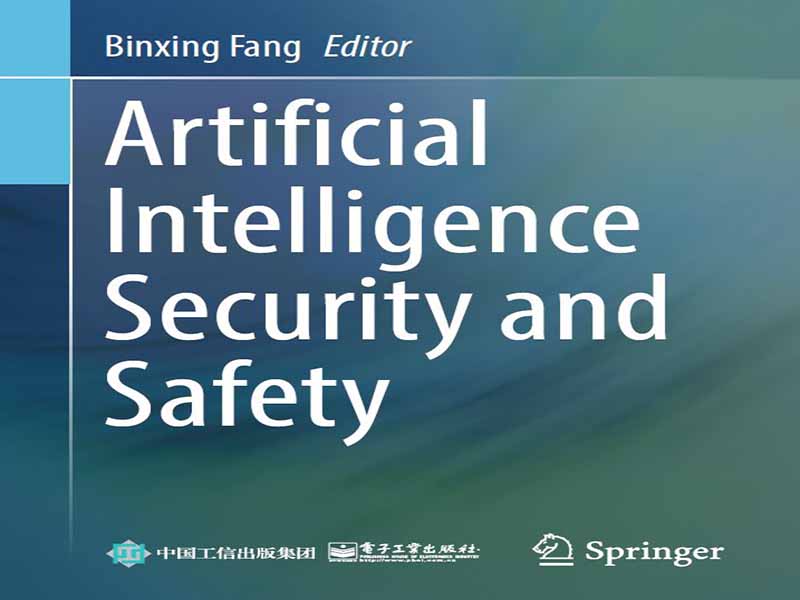- عنوان کتاب: Artificial Intelligence Security and Safety
- نویسنده: Binxing Fang
- حوزه: امنیت هوش مصوعی
- سال انتشار: 2025
- تعداد صفحه: 386
- زبان اصلی: انگلیسی
- نوع فایل: pdf
- حجم فایل: 3.26 مگابایت
هر زمان که صحبت از امنیت فضای مجازی میشود، صداهای بدبینانهای مانند «تصویر به هیچ وجه امیدوارکننده نیست» یا «برای بهبود به کار زیادی نیاز است» بلند میشوند و تصمیمگیرندگان را گیج میکنند: چرا امنیت فضای مجازی به سختی پیشرفت کرده است؟ برای خلاص شدن از نگرانیهای امنیتی فضای مجازی چه میتوان کرد؟ در واقع، تهدیدات امنیت فضای مجازی اجتنابناپذیر هستند زیرا فضای مجازی همچنان در حال تغییر است. در سمپوزیوم امنیت فضای مجازی و کاربرد فناوری اطلاعات که در 19 آوریل 2016 برگزار شد، رئیس جمهور شی جین پینگ خاطرنشان کرد که ما باید چشمانداز درستی برای امنیت فضای مجازی داشته باشیم و امنیت فضای مجازی یک فرآیند پویا است، نه ایستا. به عبارت دیگر، وضعیت امنیت فضای مجازی دائماً در حال تغییر است – به محض اینکه یک مشکل امنیتی برطرف شود، ممکن است مشکل دیگری سر بر آورد. در میان تمام عوامل مؤثر در مشکلات امنیت فضای مجازی، عوامل مرتبط با فناوریهای جدید برجستهترین هستند، زیرا فناوریهای جدید ناگزیر با نگرانیهای امنیتی جدید همراه هستند و ظهور مداوم فناوریها یا سیستمهای جدید، در نتیجه، تهدیدات امنیتی و ایمنی جدیدی را به همراه خواهد داشت. اگر در پنج سال آینده اختراع فناوریهای جدید و جلوگیری از ارتقاء سیستمهای اطلاعاتی را متوقف کنیم، تمام مشکلات فضای مجازی و امنیت اطلاعات برطرف خواهد شد و از یک فضای مجازی ۱۰۰٪ امن لذت خواهیم برد. با این حال، این فقط یک فرض خواهد بود. جهان به پیشرفت و فناوریهای جدید ادامه خواهد داد؛ از این رو، مشکلات امنیتی بعدی هرگز از ظهور باز نخواهند ایستاد. فناوریهای جدید قطعاً نگرانیهای امنیتی جدیدی را به همراه خواهند داشت که به آن اثر امنیتی همراه با امنیت فناوریهای جدید گفته میشود. چنین مشکلات امنیتی همراه در دو جنبه آشکار میشوند: اول، آسیبپذیریهای ذاتی یک فناوری جدید، سیستم فناوری جدید را به سمت عملکرد ناپایدار یا ناامن سوق میدهد که به عنوان مشکل درونزای فناوریهای جدید شناخته میشود. دوم، آسیبپذیریهای یک فناوری جدید، عملکرد عادی سیستم فناوری جدید را مختل نمیکند، بلکه تهدیدات امنیتی را به سایر زمینهها تحمیل میکند که به عنوان مشکل امنیتی مشتق شده از فناوریهای جدید شناخته میشود. گذشته از اثر امنیتی همراه، فناوریهای جدید، هنگامی که برای بهبود امنیت به کار میروند، اثر توانمندسازی امنیتی دارند. اثر توانمندسازی امنیتی یک فناوری جدید نیز در دو جنبه آشکار میشود: میتواند دفاع را تقویت کند، اما هنگامی که مورد سوءاستفاده بدخواهانه قرار گیرد، ممکن است حملات را نیز تقویت کند و امنیت سایر زمینهها را در معرض خطر قرار دهد. ظاهراً، توانمندسازی حملات توسط فناوریهای جدید یکی از دلایلی است که تضمین امنیت فضای مجازی همچنان یک چالش است. از زمان آغاز آن در دهه 1950، هوش مصنوعی فراز و نشیبهایی را پشت سر گذاشته و به صورت مارپیچی به سمت بالا تکامل یافته است. در قرن بیست و یکم، به دلیل دستاوردهای چشمگیر آن در کاربرد، هوش مصنوعی به عنوان نیروی محرکه جدید پیشرفت اجتماعی در حوزه ارتباطات اطلاعاتی شناخته شده است. در واقع، رویکردهایی مانند یادگیری عمیق و معماری نرمافزار که توسعه هوش مصنوعی و کاربرد آن را در عمل ارتقا میدهند، اختراعات جدیدی در قرن بیست و یکم هستند. بنابراین، میتوان گفت که هوش مصنوعی یک فناوری نوظهور انفورماتیک است. دلیل دیگری که هوش مصنوعی به عنوان یک فناوری جدید تلقی میشود، توجه گسترده و سرمایهگذاری عظیمی است که از سوی دولتها در سراسر جهان به خود جلب میکند، که نشان دهنده انتظار بالای جامعه جهانی از هوش مصنوعی برای منفعت جامعه بشری است. با این حال، هوش مصنوعی به عنوان یک فناوری جدید، ناگزیر هم اثر امنیتی و هم اثر توانمندسازی امنیتی را دارد. اثر امنیتیِ همراه، عمدتاً به عنوان اثر درونزای هوش مصنوعی یا مشکل امنیتی هوش مصنوعی آشکار میشود. به عنوان مثال، الگوریتمهای هوش مصنوعی به شدت به نتایج آماری متکی هستند. به طور خاص، سیستمهای یادگیری هوشمند مانند شبکههای عصبی، وزنهای پیوند را در لایه پنهان تنظیم میکنند تا اطلاعات ویژگیهای به دست آمده از یادگیری آماری سیستم را ثبت کنند. با این حال، این وزنها فراتر از توضیح هستند و بنابراین فقط میتوان از آنها استفاده کرد اما نمیتوان آنها را پیشبینی کرد. در این حالت، غیرقابل پیشبینی است که سیستم چه وزنهایی را تنظیم خواهد کرد، وزنها به چه روشی تنظیم میشوند، این تنظیم چه عواقبی خواهد داشت یا چه فرآیندهای یادگیری منجر به تنظیم میشوند، بنابراین دریچهای برای “حملات مثالی خصمانه” رایج باز میگذارد. به این معنا، حملات مثالی خصمانه را میتوان به عنوان یک مشکل امنیتی درونزای همراه هوش مصنوعی طبقهبندی کرد. به همین ترتیب، غیرقابل توضیح بودن سیستم هوش مصنوعی ممکن است عملکرد عادی سیستم را تضعیف نکند، اما آیا از کنترل خارج میشود و نمیتواند به روشی که برای آن طراحی شده است کار کند؟ آیا وقتی دیوانه میشود، تهدیدی برای انسانها ایجاد میکند؟ فکر کردن به این سؤالات در حال حاضر مو را به تن سیخ میکند. یک ربات کمکی برای معلولین، اگر به روشهای از پیش تعیینشده کار نکند، به یک تهدید ایمنی تبدیل خواهد شد و سپس ممکن است متوجه شویم که یک ربات کمهوشتر، شانس کمتری برای خارج شدن از کنترل خواهد داشت. بنابراین، این واقعیت که یک کنشگر هوش مصنوعی ممکن است از کنترل خارج شود، یک مسئله مشتق شده از هوش مصنوعی یا یک مسئله ایمنی هوش مصنوعی است…
Whenever it comes to cyberspace security, pessimistic voices like “the picture is far from rosy” or “a lot of work is needed for improvement” rise and confound the decision-makers: why cyberspace security has hardly made headway? What can be done to get rid of cyberspace security concerns? Threats to cyberspace security, in fact, are inevitable because the cyberspace remains in flux. On the Symposium on Cybersecurity and IT Application held on April 19, 2016, President Xi Jinping pointed out that we should have a correct outlook for cyberspace security, and cybersecurity is a dynamic, rather than static, process. In other words, the situation of cyberspace security keeps changing—once a security trouble is shot, another may rear its head. Among all the contributing factors to cyberspace security problems, those associated with new technologies are the most prominent in that new technologies are inevitably accompanied with new security concerns, and the constant emergence of new technologies or systems will, as a consequence, incur new security and safety menaces. If we stop inventing new technologies and preventing information systems from upgrading in the coming five years, all cyberspace and information security problems will be effaced and we will enjoy a 100% secure cyberspace. This, however, will be just hypothetical. The world will keep moving forward and new technologies; hence, the subsequent security problems will never cease to emerge. New technologies are bound to bring about new security concerns, which are called the security accompanied security effect of new technologies. Such accompanied security problems are manifested in two aspects: first, inherent vulnerabilities of a new technology will lead the new technological system to unstable or unsecure operation, which is referred to as the endogenous problem of new technologies; second, the vulnerabilities of a new technology will not impair the new technological system’s normal operation, but will impose security threats to other fields, which is referred to as the derivative security problem of new technologies. Aside from the security-accompanied effect, new technologies, when applied to improving security, have the security empowerment effect. The security empowerment effect of a new technology is also manifested in two aspects: it can empower defense, but once maliciously exploited, may also empower attacks and put the security of other fields at stake. Apparently, empowerment of attacks by new technologies is one of the reasons why ensuring cyberspace security remains a challenge. Since its inception in the 1950s, AI has gone ups and downs, evolving upwards in a spiral. In the 21st century, because of its spectacular achievements in application, AI has been recognized as a new driving force of social advancement in the field of information communication. In fact, approaches like deep learning and software architecture that promote AI development and its application in practice are new inventions in the 21st century. Therefore, it is fair to say that AI is an emerging informatics technology. Another reason why AI is deemed a new technology is the wide attention and tremendous investment it draws from governments around the world, which showcase the high expectation the global community has for AI to benefit the human society. As a new technology, however, AI inevitably has both the security-accompanied effect and security empowerment effect. The security-accompanied effect is mainly manifested as the endogenous effect of AI, or the AI security problem. For instance, AI algorithms rely heavily on statistical results. In particular, intelligent learning systems like neural networks adjust the link weights in the hidden layer to record information of features obtained by the system’s statistical learning. These weights, however, are beyond explainability, and thus they can only be used but not predicted. In this case, it is unpredictable what weights the system will adjust, in what way the weights will be adjusted, what consequences the adjustment will have, or what learning processes will result in the adjustment, therefore leaving open a window for the popular “adversarial example attacks”. In this sense, adversarial example attacks can be classified as an accompanied endogenous security problem of AI. Likewise, unexplainability of the AI system may not undermine the system’s normal operation, but will it go out of control and fail to work the way it is designed for? Will it pose threats to human beings when it goes amok? A mere thought of these questions is already hair-raising. An assistive robot for the disabled, if not working in the preset ways, will be reduced into a safety menace, and then we may find that a less intelligent robot will have a smaller chance to go out of control. Therefore, the fact that an artificial intelligence actant may go out of control is a derivative problem of AI, or an AI safety problem. In terms of the security empowerment effect of AI, the examples of AI-powered defense and AI-powered attacks are abundant. A typical example of AI-powered defense is the application of AI to cyberspace security situational awareness, while Deepfake, an AI technology that changes faces to circumvent novelty detection of facial recognition systems, is a textbook example of AI-powered attacks. As AI gains increasing attention from the governments around the world, the global community is placing more hopes on this new technology to improve people’s life and even to upgrade national governance models. As a result, most studies on AI focus on how to advance AI technologies and how to commercialize AI products. The considerable investment to AI has, however, furthered the imbalance between AI development and the AI security problems that usually fail to catch our attention. While reveling in the social progress boosted by AI technology, we are likely to overlook the AI accompanied security problems as well as AI-powered attacks. As a professional team long engaged in research on cyberspace security, we think its high time that we should pay attention to AI security and safety problems. In fact, the security and safety concerns that accompany AI development refer to not only endogenous or derivative security problems, but also a series of problems concerning codes of ethics, laws and social governance. Therefore, with the support from Cyberspace Institute of Advanced Technology of Guangzhou University, this book is edited, with a vision to increase the public awareness of AI security and safety problems together with the development of AI. This book comprises 12 chapters. Chapter 1 that introduces the history of AI development is authored by Binxing Fang and Weihong Han; Chap. 2 that expounds on AI development strategies of governments around the world is authored by Shudong Li and Binxing Fang; Chap. 3—Introduction to AI Security and Safety, is authored by Xiang Cui; Chap. 4 that focuses on AI for security is authored by Peng Liao; Chap. 5 that probes into AI security is authored by Zhaoquan Gu; Chap. 6 that discusses AI safety is authored by Shen Su and Zhihong Tian; Chap. 7 that introduces artificial intelligence actants is authored by Hui Lu; the authors for Chap. 8—AIA Safety Hoop—are Zhihong Tian and Xiang Cui; Chap. 9 focusing on security evaluation and detection of AIAs is authored by Binxing Fang and Lin Jiang; Chap. 10 that discusses codes of ethics of AI is authored by Binxing Fang and Jie Yin; Chap. 11 that explores advanced AI technologies is authored by Mohan Li; Chap. 12 that discusses the future of AI security is authored by Binxing Fang and Zhaoquan Gu. The book is compiled by Binxing Fang, Zhaoquan Gu and Xiang Cui. We want to extend our appreciation to Academician Fang Wen, who has offered much guidance during the compilation of the book. We are also grateful to Lisong Zhao and Yanbo Shen, two associate editors with Publishing House of Electronics Industry, for their efforts in publishing the Chinese version of the book. AI, in its long history of development, has been studied by different methodologies and from different technical perspectives. Though most of these studies yield similar results, scholars uphold different views. It is impossible for this book to include studies of different academic schools and cover all AI-related security and safety problems. Thus, this book only intends to serve as a modest start to inspire more discussions on AI-related security problems and technologies. We expect the readers’ understanding if there is room for improvement.
این کتاب را میتوانید از لینک زیر بصورت رایگان دانلود کنید:



































نظرات کاربران